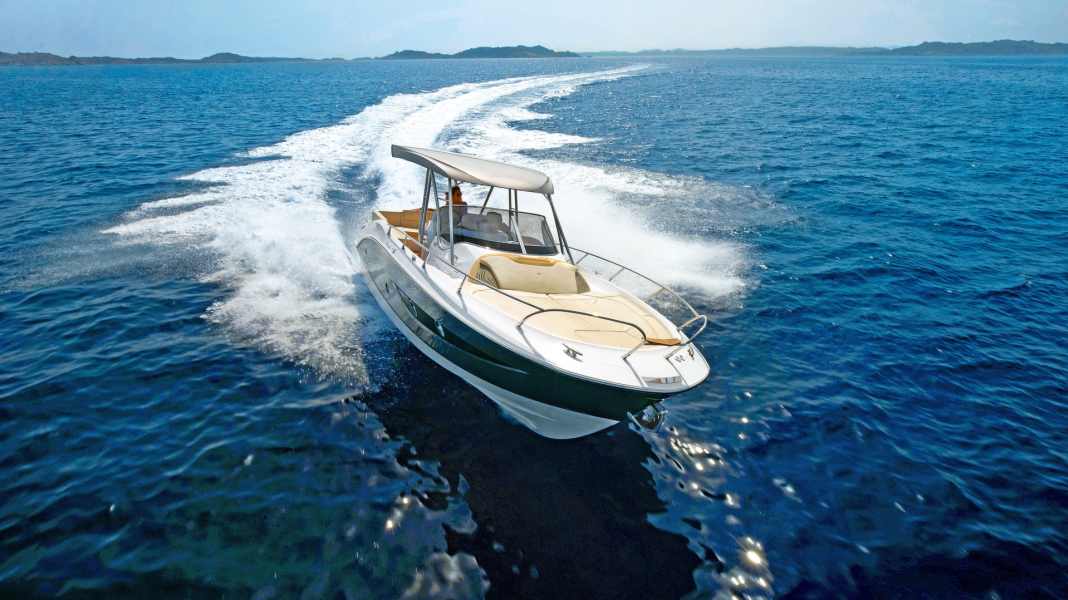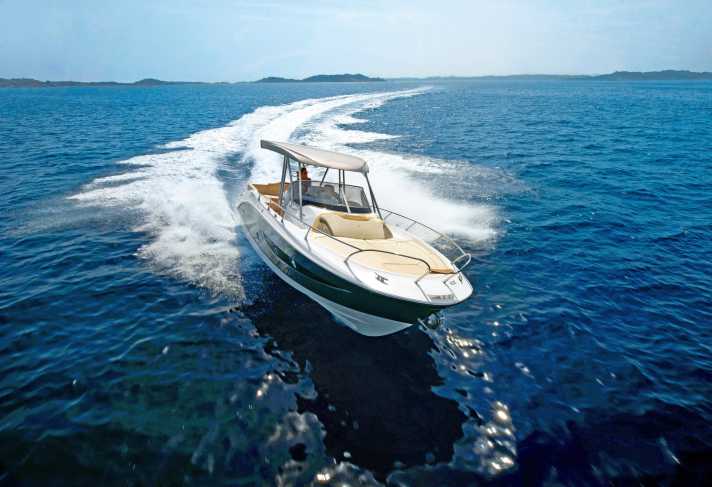







Sessa currently offers a range of twenty different models from the "Yacht and Cruiser Line" and the "Key Largo and Fishing Line" with lengths from just under six to just over 21 metres. We sail a boat from the Key Largo Line. These models can be equipped with one to three outboard motors (or with inboard motors with sterndrives). The abbreviation for the inboard boats is "IB", which can be either diesel or, as with the test boat, petrol engines; "KL" stands for Key Largo. Our test candidate, like the other Key Largo representatives at Sessa, is an all-rounder. They are all-round open boats with a centre console. With the exception of the smallest KL, all models have a cabin section under the raised sun foredeck which, as on the test boat, can extend under the cockpit with the entrance next to the helm station. There is always a full-length sunbathing area in front of the latter, while the galley, table, bench seat and stern sunbed are located behind the helm, depending on the model. The 34 IB is suitable for all types of water sports; up to four people can stay overnight. Due to its technical specifications, the Key Largo 34 IB can only be transported with a lorry and a special permit (width).
As far as the workmanship of our test boat is concerned, all ratings from good to poor are available, with the latter referring to the manual bilge pump that we requested and which is not available. There were a few slips (i.e. a rating of "sufficient") under the dashboard: open copper wires are bundled in a single terminal. We also criticise cables and hoses rubbing on sharp edges, which can be seen in front of the toilet in the underfloor cabin when the clipped panelling is removed. The fact that one or two of the plastic cut edges were left untreated does not detract from the otherwise good impression: high-gloss gelcoat on the outside and sealed laminate surfaces on the inside. There is nothing to criticise about the work of the carpenters and upholsterers.
Driving and manoeuvring
Two motors guarantee manoeuvrable behaviour at slow speeds. Shifting one drive into forward gear and the other into reverse means turning almost on the spot. If you keep both gears in forward position, a full circle measures about 1 ¼ boat lengths. Even longer reverse journeys are possible without much effort. If crosswinds or cross-currents disrupt manoeuvres at slow speed, you can use the bow thruster (extra) to help yourself, and we sail through the slow passages at speeds of 600-1200 rpm to keep the waves generated by the boat at a low level. If someone changes their position during this time, this has no effect on the course or heeling, the test boat maintains the course it is on.
As the speed increases, it begins to glide with the drives fully trimmed from around 2200 rpm (just under 12 knots). Thanks to low trim at the transition from displacement to planing speed, good foresight is maintained. From 3000 rpm (18 knots), the test boat switches completely to planing speed and accelerates to a top speed of 39 knots on the Mediterranean waters off Varazze. The fact that the engines do not turn higher than 4900 rpm - a maximum of 5200 rpm is permitted - is evidence of somewhat oversized duoprop propellers, as the boat is not really loaded with three people and a full fuel tank. The KL 34 IB requires little power trim. In our case, it is sufficient to trim the drives from -7 to -4, any more than this will only lead to the boat rocking permanently, but not rocking up.
After analysing our measured values, we calculated a theoretical range of 366 nm plus 15 % reserve with one tank of normal petrol at slow speed. At fast planing speed, the test boat is travelling at a speed of 23 knots with both engines running at 3500 rpm. This means you can travel around 235 nm on one tank of fuel, and with both throttles on the table, a visit to a bunker station is required after just under 200 nm if the reserves are to be maintained in both cases. This means that even at full throttle, the test boat fulfils our requirement of at least 150 nm range plus reserve. That's good.
There is also nothing to criticise about the sound insulation of the engine compartment, as the sound pressure only scrapes the 85 dB/A comfort limit at full throttle. Less favourable is a material sample taken, which does not extinguish itself during the combustion test. The extreme manoeuvres performed at 75% top speed reveal the "key Largo genes" that we have come to know in the model series so far: The boat needs little trim and behaves somewhat frantically in tight and fast turns. Our test boat is no exception and, with the drives fully trimmed, brakes itself down to the lower planing speed, which we measured at 13 knots, with a slight sideways rocking as the bends become tighter and tighter.
If, on the other hand, the Z-drives are kept in optimum trim, the response is increasingly violent rocking; at the narrowest point the propellers ventilate and force the aircraft to start up again. The good thing about this is that the hull does not hook. The situation is somewhat different in the 180° turns, in which the boat rocks over starboard with increasing speed and the hull hooks in slightly to strongly when the test boat completes the turn within two to three boat lengths of the curve.
We measured centrifugal forces of 2 g at the driving position and 1 g in front of the cockpit bench seat. Thanks to the pronounced bucket seats, these are well tolerated by the driver and co-driver and durable for rear passengers. Over the port side, everything is more subdued and quieter. Here we measured stable centrifugal forces of 1 g on both the driving position and the cockpit bench, while our test boat swept round the corner within two boat lengths. On the imaginary slalom course, the KL 34 IB can be made to oscillate safely over its longitudinal axis, and when the rudder is twisted, it follows the chosen course without complaint.
There is little to say about the rough water behaviour, as the Mediterranean showed its calm side on the test day. The hull makes a good impression when travelling over its own waves. Conclusion: During cruising, the test boat remains in the green zone, and at high speeds and extreme manoeuvres it becomes hectic, but remains predictable. Still good.
The skipper's workplace is clearly organised. A compass is standard, the depth sounder costs extra and there is no windscreen wiper for the plastic windscreen. Instead, there is a handy windscreen frame which, like the hardtop linkage, is a little too far away for the co-driver to hold on to. The fact that the co-driver sits in front of the cab door and, unlike the driver, has no footrest, takes some getting used to.
Engine, tank, electrics
We drive the Key Largo 34 IB with two 320 hp 5.7 GXI V8 engines from Volvo Penta, with which the boat appears to be suitably equipped. The two power packs are easily accessible under the stern bench seat, which can be raised at the touch of a button, complete with sunbed. The technical and electrical installations make a good impression. The batteries are neatly stored in separate plastic boxes; the associated main battery switches are operated by relays on the switch panel in the cabin, where the thermal fuses are also located.
Security
This is where the hull scores with its predictable handling characteristics. The height of the cockpit interior walls is suitable, but a rear entrance door that is only 0.31 m high is too low. We rate the remotely switchable fuel taps and pre-filter as good, but without water alarm sensors they are pointless. Four electric bilge pumps are helpful, but you need a manual bilge pump if the batteries are flat, which we looked for in vain, as did the emergency stop switch (quick stop) for the engines. The fire extinguishing system in the engine compartment is good; more handholds would be desirable.
Living, cockpit and equipment
The interior fittings and furnishings convey a touch of luxury, while the double-shell construction, fabric-covered ceiling panels, leather applications and wooden furniture create a cosy feel. There is a seating area in the bow that can be converted into a V-berth; there is no mattress ventilation. Storage space is limited: There is it under the bow seat cushion and in the small locker, to port at the entrance. Two longitudinal windows with opening portholes let in light and air.
Behind the forward cabin on the starboard side is the bathroom with shower and toilet, which is a little cramped for larger people. The underfloor cabin under the cockpit can be entered in a crouched position, with room for two to lie down. Two berths can be converted into one continuous area by inserting cushions, while two portholes provide light and air. The galley is located behind the driver's and co-driver's seats in the cockpit, a sink with running water (hot/cold) is standard, but a refrigerator, cooker and icemaker are not.
Behind the galley there is a table and an L-shaped bench seat with storage space underneath. A compass and RINA-approved navigation lights are included as standard. On our test boat, a hardtop with a retractable bimini attached to the end protects against too much sun. A tarpaulin costs extra. The bathing ladder is located in the bathing platform - a grab handle is provided. Six mooring cleats, a self-draining bow anchor locker with winch, chain and anchor are standard.

